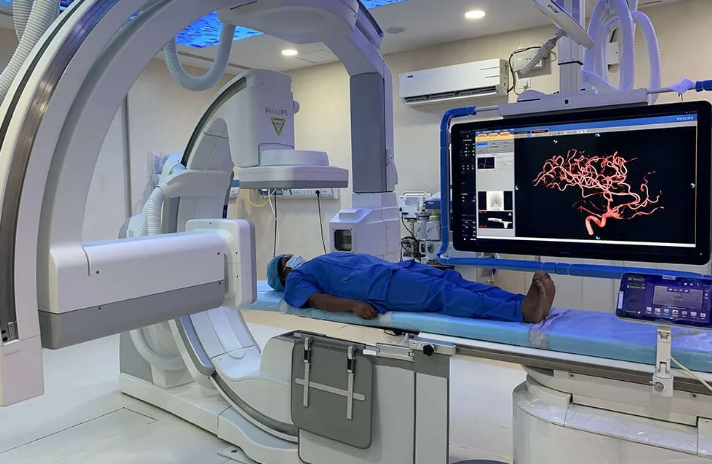In the rapidly evolving landscape of modern medicine, interventional radiology has emerged as a groundbreaking field that is revolutionizing the way we diagnose and treat a wide range of medical conditions. From minimally invasive procedures to advanced imaging techniques, radiology offers patients innovative solutions with less risk, faster recovery times, and improved outcomes. In this blog post, we’ll explore the role of radiology in healthcare and how it is reshaping the treatment paradigm from diagnosis to treatment.
Understanding Interventional Radiology
It is a medical specialty that uses imaging guidance, such as X-rays, ultrasound, and magnetic resonance imaging (MRI), to perform minimally invasive procedures for diagnostic and therapeutic purposes. Interventional radiologists are specially trained physicians who utilize advanced imaging technology to precisely target and treat diseases without the need for traditional surgery.
The Diagnostic Power of Interventional Radiology
One of the key areas where radiology is making waves is in the realm of diagnosis. In many cases, this approach allows physicians to obtain tissue samples for biopsy via tiny incisions, reducing patient discomfort and recovery time. For example, if a patient has an abnormal growth in their lungs, an interventional radiologist can use real-time imaging to guide a needle to the growth and take a small tissue sample. This procedure, known as image-guided biopsy, is less invasive than surgical biopsy and reduces the risk of complications.
Advancements in Diagnosis
One of the key contributions of interventional to healthcare is its ability to improve the accuracy and efficiency of diagnostic procedures. Through techniques such as angiography, fluoroscopy, and computed tomography (CT) scans, interventional radiologists can obtain detailed images of the body’s internal structures to diagnose a variety of conditions, including vascular diseases, tumours, and organ dysfunction. These advanced imaging modalities enable early detection and intervention, leading to better patient outcomes.
Minimally Invasive Treatments
It offers a wide range of minimally invasive treatments for conditions that were once only manageable through open surgery. From angioplasty and stent placement for blocked arteries to tumour ablation and embolization for cancerous growths, interventional radiologists use precise, image-guided techniques to deliver targeted therapy directly to the source of the problem. These minimally invasive procedures result in less trauma to the body, reduced pain, shorter hospital stays, and faster recovery times for patients.
Precision Medicine Approach
Interventional exemplifies the concept of precision medicine by tailoring treatments to the individual needs of each patient. Through advanced imaging and innovative techniques, interventional radiologists can customize procedures to target specific areas of the body with unparalleled accuracy. This personalized approach maximizes therapeutic efficacy while minimizing the risk of complications, ensuring optimal outcomes for patients with complex medical conditions.
Expanding Treatment Options
The field of interventional radiology continues to evolve rapidly, with new techniques and technologies constantly being developed to expand treatment options and improve patient care. From drug-eluting stents and bioresorbable scaffolds for vascular interventions to targeted drug delivery systems and image-guided therapy for cancer treatment, interventional radiologists are at the forefront of innovation, pushing the boundaries of what is possible in modern healthcare.
Collaborative Care Approach
Interventional plays a crucial role in multidisciplinary care teams, collaborating closely with other medical specialties to provide comprehensive, patient-centred treatment plans. Whether working alongside surgeons, oncologists, cardiologists, or other specialists, interventional radiologists contribute their unique expertise and skill set to deliver integrated care that addresses the diverse needs of each patient. This collaborative approach ensures that patients receive the most appropriate and effective treatment options available.
Minimizing Risks and Enhancing Recovery
One of the most significant advantages of interventional is its ability to minimize risks associated with traditional surgical procedures. Since these procedures involve smaller incisions, they often result in less pain, lower risk of infection, and shorter hospital stays. Moreover, the recovery time after a radiology procedure is typically shorter than after traditional surgery. This means patients can return to their normal routines more quickly, improving their overall quality of life.
The Future of Interventional Radiology in Healthcare
The future of interventional in healthcare looks promising. As technology continues to advance, so too will the capabilities of radiology. It’s expected that this field will continue to expand, offering even more minimally invasive options for diagnosing and treating a variety of conditions. Researchers are also exploring the potential of combining interventional with other therapies, such as immunotherapy for cancer treatment. These combinations could offer even more effective treatment options for patients in the future.
Conclusion
Interventional radiology is transforming healthcare by offering minimally invasive solutions for diagnosing and treating a wide range of medical conditions. From advanced imaging techniques for accurate diagnosis to innovative procedures for targeted therapy, interventional radiologists are revolutionizing the way we approach patient care. By combining precision medicine with cutting-edge technology and collaborative teamwork, radiology is paving the way for a future where safer, more effective treatments are available to patients around the world.











